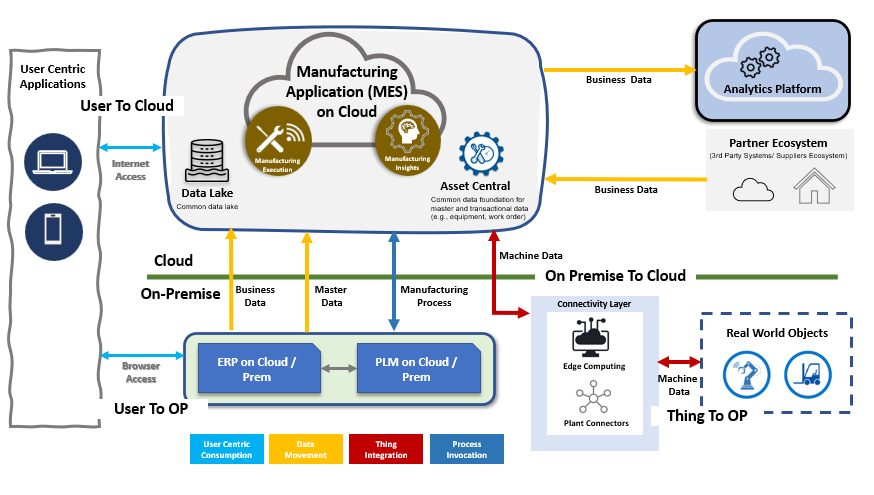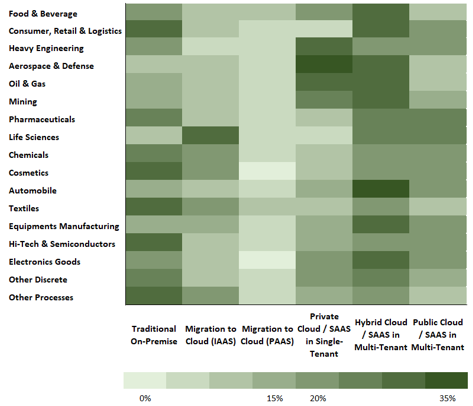With the advancement of Cloud technologies, the business entities are migration their applications to Cloud that enables them to save OPEX & bunch of other benefits. Migration of MES on Cloud has been the moot point between business and IT estates within the organization. As MES-MOM applications are integral in executing the manufacturing processes and driving the SCM operations rapidly. it has traditionally been set on-premises closer to plant applications for a seamless experience and to eliminate business disruptions and hence a strong resentment against a change from Business and Site IT. Apparently, there has been a consistent push from leadership and Corporate IT to harmonize applications infrastructure and align with their Cloud-first approach.
Cloudification of MES is a crucial prerequisite for digital transformation and Smart Factory initiatives. Over the past few years, there have been seamless and successful migrations across various organizations without any aftereffects on business. It is important to understand the underlying challenges as perceived by business and site IT to address them amicably to embrace the Cloudification journey. Some of the important ones includes the storage and management of humongous volumes of Manufacturing data, the reliability of integration between Shop floor entities and Cloud MES, data security, high-availability and seamless accessibility of application over Cloud, dependence on cloud provider, achieving a bespoke MES (especially for SaaS MES applications), real time processing of time series Manufacturing data, OT security and so on. Most of these concerns are addressed through an effective and resilient cloud systems setup and an Edge computing framework such as a hybrid Edge. The Edge handles real-time processing and secure closed-loop automation, while cloud handles large chunks of data, dashboards, reports and global operations visibility. All that is needed is to effectively drive mindset change, educate on cloud services and offerings and change the perception of manufacturers.
Many enterprises are willing to migrate MES to cloud as the benefits outweigh the cost and risk associated with adoption. Empowered with artificial intelligence (AI) and digital twins amongst other next-gen technologies, MES on cloud is set to become an indispensable platform for driving operational excellence and make production process more intelligent than ever. Use cases including convergence of MES and IIOT over cloud, increased integration with AI platforms, embracing Digital Twins, ease of Cloud operations/infrastructure setup and maintenance, savings on OPEX, invariably resource optimization with multi-plant MES influences the initiative to be cloud compliant from MES perspective.
The Architecture

Cloudification of MES can follow the models of IaaS, PaaS or a SaaS one. While IaaS and PaaS models drive migration to cloud without changes to the underlying architecture, it is a ‘lift & shift’ model and supports the enterprise initiative of application consolidation on cloud. Though it meets the objective, the true essence of the cloudification of MES lies with the SaaS cloud model, where the MES application is a native cloud application managed by the provider. A SaaS MES combines many possibilities with connected modules, digitally orchestrating sustainable manufacturing, resulting in lower costs for finished products, increased margins, and higher returns on assets. It helps break down manufacturing silos through a single data model and a well-connected and integrated manufacturing process. Powered by AI and advanced analytics framework on cloud, it enables utilizing business and operational data points to analyze the root cause of inefficiencies and predict failures in real-time. Further, it assists to automate processes and resources, improving manufacturing efficiency, quality and productivity.
As we move forward, we try to lay down an ideal architecture bringing together multiple components packed together to set up the manufacturing ecosystem for the enterprise; essentially a centralized MES driving production processes across the board; thus encapsulating the differences between sites in terms of processes, machines, operations, setups etc. and can best serve the needs of individual locations while providing common KPIs for analyzing location manufacturing performance and health.
While ERP, along with PLM, can be the single source of planning and master data for all shop floor processing, the plants may use their individual Data Concentrator PLCs and Edge Device combination or may share the architecture based on region (or it may use a Web Application Server for collecting data across sites before pushing to MES on the Cloud). However, all sites may have to use some Plant Connector APIs, such as OPC servers, for data collection. All data rolls up to common KPIs using the MES Manufacturing Insights (Reporting app) with a common Data Lake on the cloud. Data can be available to other cloud-based analytics platforms for enhanced/advanced analytics. The Edge system provides adequate storage and data processing capabilities to bridge gaps arising from connectivity/network/ availability and be a definitive option ensuring no data loss and zero impact on operations. The continuous data sync between cloud MES and Edge system keeps both platforms in sync for mission-critical activities such as process execution, manufacturing data and real-time intelligence information on assets and resources from the shop floor. The store-and-forward approach through MES Edge provides a reliable way for implementing an in-memory cache for MES on cloud. It ensures the delivery of shop floor data to cloud MES and stored efficiently in MES Edge, prevents Data loss prevention, guaranteed ordering and enhanced performance.
The business systems on cloud shall stay connected to the cloud MES, bring together the critical analytics paramount to the business, and provide an integrated view of enterprise and production systems on a page. A key architecture consideration is offline operations. The architecture should support MES functions even during connectivity and network issues to the cloud. Production and production operations should not be impacted in any case.
Advantages with MES on Cloud
Cloud-based MES drives greater agility and flexibility at the helm of lower control than on-premises MES. Some of the key advantages includes scalable and swift configuration framework, real time data accessibility, manufacturing in mixed mode with more resiliency to disruptions in supply chain with better predictability, superior customer experience with state-of-the-art analytics, a drastic reduction of ownership cost, flexibility in operations, smart systems integration, periodic updates for additional values, efficient business systems collaborations amongst others. In addition to this, it helps unravel hidden opportunities to boost operational efficiency, gain agility and improved performance, intelligent insights across the hierarchies and enterprise and importantly reduced local data storage costs.
The Industry Trends
Our analysis and interactions with various manufacturers show that as many as 70% of MES users prefer cloud over on-premises. While just over 15% have migrated to Cloud MES (SaaS), the rest plan to “lift and shift” MES applications soon. From geographical coverage standpoint, we discovered a surge in North American manufacturers migrating towards cloud-hosted MES solutions, Europe and the APAC region are increasingly interested in migrating MES to the cloud. At the same time, traditionally labor-intensive markets may transition significantly later. Apparently, we saw that most industry segments intend to move towards SaaS MES in a hybrid cloud setup. Currently, the urge towards cloudification of MES systems is more prominent in discrete industries, and the trend has steadily captured all segments over time.

Migrating to a cloud-based MES-MOM product is strategic and requires decision-making. This step involves considering various factors and risks. Importantly, they must present a business case to senior leadership to pave the way. Key factors that could influence the decision making include the current factory maturity, overall cloud strategy of the enterprise, volumes and complexity of manufacturing processes, degree of customizations within MES application, digital awareness across all levels and roles, positioning of OT systems, change management qualification and ROI amongst others.
Conclusion
Harnessing the power of digital transformation in manufacturing under the I4.0 umbrella has been the norm worldwide despite their spends, size and revenues. With the core objective of cloud-first, cloudification of MES is a key step and paves the way for cloudification of the entire MOM ecosystem (Level 3 systems). Most MES platforms in the market are transforming themselves to deliver SaaS packages that inherit traits of the IoT ecology. Successful and proper implementation of cloud MES delivers attractive returns across a wide range of segments, leading to more empowered decision-making, new opportunities for process optimizations, upskilling and cross-functional collaboration, eventually navigating your next level.








